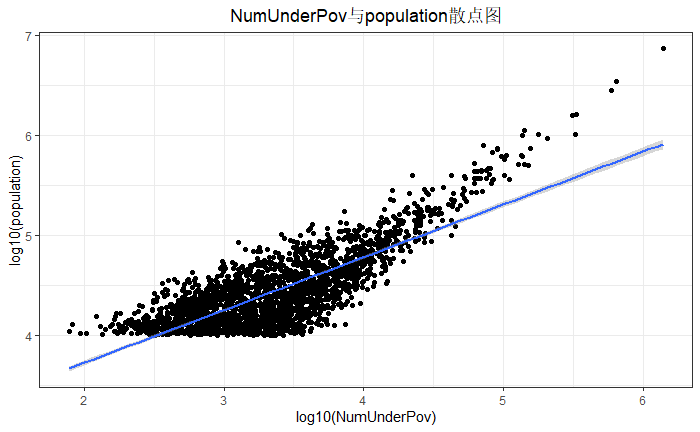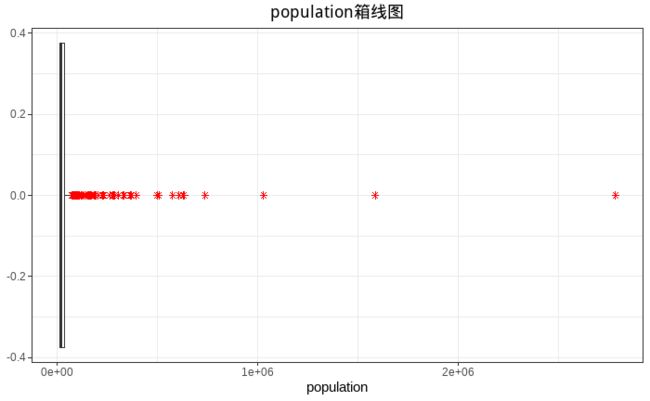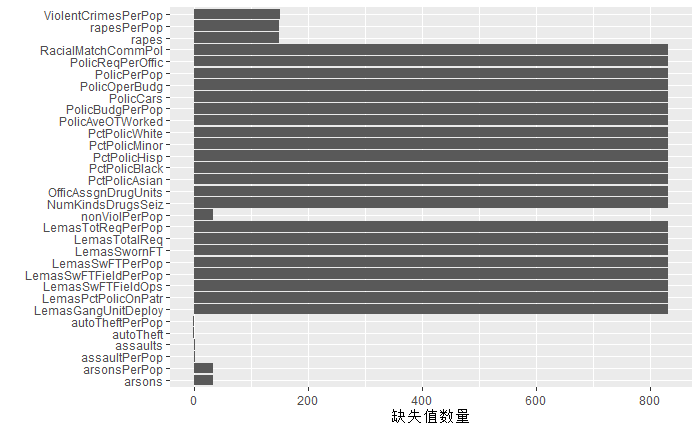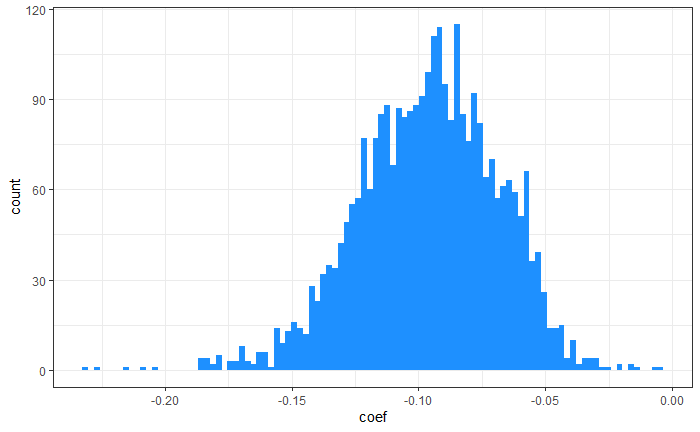1、读入数据
path <- "C:\\Users\\Admin\\Documents\\R\\ks\\"
file1 <- "CommViolPredUnnormalizedData.csv"
file2 <- "newdata.csv"
df1 <- read.csv(paste0(path, file1), header = T, stringsAsFactors = F)
pre <- read.csv(paste0(path, file2), header = T, stringsAsFactors = F)
2、导入tidyverse包
library(pacman)
p_load(tidyverse)
3、查看数据名称,并任选两个变量做出散点图
df1 <- tbl_df(df1)
# 查看数据名称
name <- names(df1)
name
## [1] "communityname" "state" "countyCode"
## [4] "communityCode" "fold" "population"
## [7] "householdsize" "racepctblack" "racePctWhite"
## [10] "racePctAsian" "racePctHisp" "agePct12t21"
## [13] "agePct12t29" "agePct16t24" "agePct65up"
## [16] "numbUrban" "pctUrban" "medIncome"
## [19] "pctWWage" "pctWFarmSelf" "pctWInvInc"
## [22] "pctWSocSec" "pctWPubAsst" "pctWRetire"
## [25] "medFamInc" "perCapInc" "whitePerCap"
## [28] "blackPerCap" "indianPerCap" "AsianPerCap"
## [31] "OtherPerCap" "HispPerCap" "NumUnderPov"
## [34] "PctPopUnderPov" "PctLess9thGrade" "PctNotHSGrad"
## [37] "PctBSorMore" "PctUnemployed" "PctEmploy"
## [40] "PctEmplManu" "PctEmplProfServ" "PctOccupManu"
## [43] "PctOccupMgmtProf" "MalePctDivorce" "MalePctNevMarr"
## [46] "FemalePctDiv" "TotalPctDiv" "PersPerFam"
## [49] "PctFam2Par" "PctKids2Par" "PctYoungKids2Par"
## [52] "PctTeen2Par" "PctWorkMomYoungKids" "PctWorkMom"
## [55] "NumKidsBornNeverMar" "PctKidsBornNeverMar" "NumImmig"
## [58] "PctImmigRecent" "PctImmigRec5" "PctImmigRec8"
## [61] "PctImmigRec10" "PctRecentImmig" "PctRecImmig5"
## [64] "PctRecImmig8" "PctRecImmig10" "PctSpeakEnglOnly"
## [67] "PctNotSpeakEnglWell" "PctLargHouseFam" "PctLargHouseOccup"
## [70] "PersPerOccupHous" "PersPerOwnOccHous" "PersPerRentOccHous"
## [73] "PctPersOwnOccup" "PctPersDenseHous" "PctHousLess3BR"
## [76] "MedNumBR" "HousVacant" "PctHousOccup"
## [79] "PctHousOwnOcc" "PctVacantBoarded" "PctVacMore6Mos"
## [82] "MedYrHousBuilt" "PctHousNoPhone" "PctWOFullPlumb"
## [85] "OwnOccLowQuart" "OwnOccMedVal" "OwnOccHiQuart"
## [88] "OwnOccQrange" "RentLowQ" "RentMedian"
## [91] "RentHighQ" "RentQrange" "MedRent"
## [94] "MedRentPctHousInc" "MedOwnCostPctInc" "MedOwnCostPctIncNoMtg"
## [97] "NumInShelters" "NumStreet" "PctForeignBorn"
## [100] "PctBornSameState" "PctSameHouse85" "PctSameCity85"
## [103] "PctSameState85" "LemasSwornFT" "LemasSwFTPerPop"
## [106] "LemasSwFTFieldOps" "LemasSwFTFieldPerPop" "LemasTotalReq"
## [109] "LemasTotReqPerPop" "PolicReqPerOffic" "PolicPerPop"
## [112] "RacialMatchCommPol" "PctPolicWhite" "PctPolicBlack"
## [115] "PctPolicHisp" "PctPolicAsian" "PctPolicMinor"
## [118] "OfficAssgnDrugUnits" "NumKindsDrugsSeiz" "PolicAveOTWorked"
## [121] "LandArea" "PopDens" "PctUsePubTrans"
## [124] "PolicCars" "PolicOperBudg" "LemasPctPolicOnPatr"
## [127] "LemasGangUnitDeploy" "LemasPctOfficDrugUn" "PolicBudgPerPop"
## [130] "murders" "murdPerPop" "rapes"
## [133] "rapesPerPop" "robberies" "robbbPerPop"
## [136] "assaults" "assaultPerPop" "burglaries"
## [139] "burglPerPop" "larcenies" "larcPerPop"
## [142] "autoTheft" "autoTheftPerPop" "arsons"
## [145] "arsonsPerPop" "ViolentCrimesPerPop" "nonViolPerPop"
# 查看数据类型
str(df1)
## Classes 'tbl_df', 'tbl' and 'data.frame': 2214 obs. of 147 variables:
## $ communityname : chr "BerkeleyHeightstownship" "Marpletownship" "Tigardcity" "Gloversvillecity" ...
## $ state : chr "NJ" "PA" "OR" "NY" ...
## $ countyCode : chr "39" "45" "?" "35" ...
## $ communityCode : chr "5320" "47616" "?" "29443" ...
## $ fold : int 1 1 1 1 1 1 1 1 1 1 ...
## $ population : int 11980 23123 29344 16656 11245 140494 28700 59459 74111 103590 ...
## $ householdsize : num 3.1 2.82 2.43 2.4 2.76 2.45 2.6 2.45 2.46 2.62 ...
## $ racepctblack : num 1.37 0.8 0.74 1.7 0.53 ...
## $ racePctWhite : num 91.8 95.6 94.3 97.3 89.2 ...
## $ racePctAsian : num 6.5 3.44 3.43 0.5 1.17 0.9 1.47 0.4 1.25 0.92 ...
## $ racePctHisp : num 1.88 0.85 2.35 0.7 0.52 ...
## $ agePct12t21 : num 12.5 11 11.4 12.6 24.5 ...
## $ agePct12t29 : num 21.4 21.3 25.9 25.2 40.5 ...
## $ agePct16t24 : num 10.9 10.5 11 12.2 28.7 ...
## $ agePct65up : num 11.3 17.2 10.3 17.6 12.6 ...
## $ numbUrban : int 11980 23123 29344 0 0 140494 28700 59449 74115 103590 ...
## $ pctUrban : num 100 100 100 0 0 100 100 100 100 100 ...
## $ medIncome : int 75122 47917 35669 20580 17390 21577 42805 23221 25326 17852 ...
## $ pctWWage : num 89.2 79 82 68.2 69.3 ...
## $ pctWFarmSelf : num 1.55 1.11 1.15 0.24 0.55 1 0.39 0.67 2.93 0.86 ...
## $ pctWInvInc : num 70.2 64.1 55.7 39 42.8 ...
## $ pctWSocSec : num 23.6 35.5 22.2 39.5 32.2 ...
## $ pctWPubAsst : num 1.03 2.75 2.94 11.71 11.21 ...
## $ pctWRetire : num 18.4 22.9 14.6 18.3 14.4 ...
## $ medFamInc : int 79584 55323 42112 26501 24018 27705 50394 28901 34269 24058 ...
## $ perCapInc : int 29711 20148 16946 10810 8483 11878 18193 12161 13554 10195 ...
## $ whitePerCap : int 30233 20191 17103 10909 9009 12029 18276 12599 13727 12126 ...
## $ blackPerCap : int 13600 18137 16644 9984 887 7382 17342 9820 8852 5715 ...
## $ indianPerCap : int 5725 0 21606 4941 4425 10264 21482 6634 5344 11313 ...
## $ AsianPerCap : int 27101 20074 15528 3541 3352 10753 12639 8802 8011 5770 ...
## $ OtherPerCap : chr "5115" "5250" "5954" "2451" ...
## $ HispPerCap : int 22838 12222 8405 4391 1328 8104 22594 6187 5174 6984 ...
## $ NumUnderPov : int 227 885 1389 2831 2855 23223 1126 10320 9603 27767 ...
## $ PctPopUnderPov : num 1.96 3.98 4.75 17.23 29.99 ...
## $ PctLess9thGrade : num 5.81 5.61 2.8 11.05 12.15 ...
## $ PctNotHSGrad : num 9.9 13.72 9.09 33.68 23.06 ...
## $ PctBSorMore : num 48.2 29.9 30.1 10.8 25.3 ...
## $ PctUnemployed : num 2.7 2.43 4.01 9.86 9.08 5.72 4.85 8.19 4.18 8.39 ...
## $ PctEmploy : num 64.5 62 69.8 54.7 52.4 ...
## $ PctEmplManu : num 14.65 12.26 15.95 31.22 6.89 ...
## $ PctEmplProfServ : num 28.8 29.3 21.5 27.4 36.5 ...
## $ PctOccupManu : num 5.49 6.39 8.79 26.76 10.94 ...
## $ PctOccupMgmtProf : num 50.7 37.6 32.5 22.7 27.8 ...
## $ MalePctDivorce : num 3.67 4.23 10.1 10.98 7.51 ...
## $ MalePctNevMarr : num 26.4 28 25.8 28.1 50.7 ...
## $ FemalePctDiv : num 5.22 6.45 14.76 14.47 11.64 ...
## $ TotalPctDiv : num 4.47 5.42 12.55 12.91 9.73 ...
## $ PersPerFam : num 3.22 3.11 2.95 2.98 2.98 2.89 3.14 2.95 3 3.11 ...
## $ PctFam2Par : num 91.4 86.9 78.5 64 58.6 ...
## $ PctKids2Par : num 90.2 85.3 78.8 62.4 55.2 ...
## $ PctYoungKids2Par : num 95.8 96.8 92.4 65.4 66.5 ...
## $ PctTeen2Par : num 95.8 86.5 75.7 67.4 79.2 ...
## $ PctWorkMomYoungKids : num 44.6 51.1 66.1 59.6 61.2 ...
## $ PctWorkMom : num 58.9 62.4 74.2 70.3 68.9 ...
## $ NumKidsBornNeverMar : int 31 43 164 561 402 1511 263 2368 751 3537 ...
## $ PctKidsBornNeverMar : num 0.36 0.24 0.88 3.84 4.7 1.58 1.18 4.66 1.64 4.71 ...
## $ NumImmig : int 1277 1920 1468 339 196 2091 2637 517 1474 4793 ...
## $ PctImmigRecent : num 8.69 5.21 16.42 13.86 46.94 ...
## $ PctImmigRec5 : num 13 8.65 23.98 13.86 56.12 ...
## $ PctImmigRec8 : num 21 13.3 32.1 15.3 67.9 ...
## $ PctImmigRec10 : num 30.9 22.5 35.6 15.3 69.9 ...
## $ PctRecentImmig : num 0.93 0.43 0.82 0.28 0.82 0.32 1.05 0.11 0.47 0.72 ...
## $ PctRecImmig5 : num 1.39 0.72 1.2 0.28 0.98 0.45 1.49 0.2 0.67 1.07 ...
## $ PctRecImmig8 : num 2.24 1.11 1.61 0.31 1.18 0.57 2.2 0.25 0.93 1.63 ...
## $ PctRecImmig10 : num 3.3 1.87 1.78 0.31 1.22 0.68 2.55 0.29 1.07 2.31 ...
## $ PctSpeakEnglOnly : num 85.7 87.8 93.1 95 94.6 ...
## $ PctNotSpeakEnglWell : num 1.37 1.81 1.14 0.56 0.39 0.6 0.6 0.28 0.43 2.51 ...
## $ PctLargHouseFam : num 4.81 4.25 2.97 3.93 5.23 3.08 5.08 3.85 2.59 6.7 ...
## $ PctLargHouseOccup : num 4.17 3.34 2.05 2.56 3.11 1.92 3.46 2.55 1.54 4.1 ...
## $ PersPerOccupHous : num 2.99 2.7 2.42 2.37 2.35 2.28 2.55 2.36 2.32 2.45 ...
## $ PersPerOwnOccHous : num 3 2.83 2.69 2.51 2.55 2.37 2.89 2.42 2.77 2.47 ...
## $ PersPerRentOccHous : num 2.84 1.96 2.06 2.2 2.12 2.16 2.09 2.27 1.91 2.44 ...
## $ PctPersOwnOccup : num 91.5 89 64.2 58.2 58.1 ...
## $ PctPersDenseHous : num 0.39 1.01 2.03 1.21 2.94 2.11 1.47 1.9 1.67 6.14 ...
## $ PctHousLess3BR : num 11.1 23.6 47.5 45.7 55.6 ...
## $ MedNumBR : int 3 3 3 3 2 2 3 2 2 2 ...
## $ HousVacant : int 64 240 544 669 333 5119 566 2051 1562 5606 ...
## $ PctHousOccup : num 98.4 97.2 95.7 91.2 92.5 ...
## $ PctHousOwnOcc : num 91 84.9 57.8 54.9 53.6 ...
## $ PctVacantBoarded : num 3.12 0 0.92 2.54 3.9 2.09 1.41 6.39 0.45 5.64 ...
## $ PctVacMore6Mos : num 37.5 18.33 7.54 57.85 42.64 ...
## $ MedYrHousBuilt : int 1959 1958 1976 1939 1958 1966 1956 1954 1971 1960 ...
## $ PctHousNoPhone : num 0 0.31 1.55 7 7.45 ...
## $ PctWOFullPlumb : num 0.28 0.14 0.12 0.87 0.82 0.31 0.28 0.49 0.19 0.33 ...
## $ OwnOccLowQuart : int 215900 136300 74700 36400 30600 37700 155100 26300 54500 28600 ...
## $ OwnOccMedVal : int 262600 164200 90400 49600 43200 53900 179000 37000 70300 43100 ...
## $ OwnOccHiQuart : int 326900 199900 112000 66500 59500 73100 215500 52400 93700 67400 ...
## $ OwnOccQrange : int 111000 63600 37300 30100 28900 35400 60400 26100 39200 38800 ...
## $ RentLowQ : int 685 467 370 195 202 215 463 186 241 192 ...
## $ RentMedian : int 1001 560 428 250 283 280 669 253 321 281 ...
## $ RentHighQ : int 1001 672 520 309 362 349 824 325 387 369 ...
## $ RentQrange : int 316 205 150 114 160 134 361 139 146 177 ...
## $ MedRent : int 1001 627 484 333 332 340 736 338 355 353 ...
## $ MedRentPctHousInc : num 23.8 27.6 24.1 28.7 32.2 26.4 24.4 26.3 25.2 29.6 ...
## $ MedOwnCostPctInc : num 21.1 20.7 21.7 20.6 23.2 17.3 20.8 15.1 20.7 19.4 ...
## $ MedOwnCostPctIncNoMtg: num 14 12.5 11.6 14.5 12.9 11.7 12.5 12.2 12.8 13 ...
## $ NumInShelters : int 11 0 16 0 2 327 0 21 125 43 ...
## $ NumStreet : int 0 0 0 0 0 4 0 0 15 4 ...
## $ PctForeignBorn : num 10.66 8.3 5 2.04 1.74 ...
## [list output truncated]
# 选取NumUnderPov和population画散点图
ggplot(df1,aes(log10(NumUnderPov),log10(population))) +
geom_point() +
geom_smooth(method = "lm",se=T) +
theme_bw() +
labs(title = "NumUnderPov与population散点图") +
theme(plot.title = element_text(hjust = 0.5))
从整体上来看,NumUnderPov与population之间成正相关关系。
4、找出countyCode和communityCode的缺失值,并删除相应行
nrow(df1)
## [1] 2214
df2 <- df1 %>% filter(countyCode != "?" & communityCode != "?")
nrow(df2)
## [1] 991
5、找出population中的极端值,并滤掉相应的行
# 画出population的箱线图
ggplot(df2,aes(y=population)) +
geom_boxplot(outlier.colour = "red", outlier.shape = 8) +
coord_flip() +
labs(title = "population箱线图") +
theme_bw() +
theme(plot.title = element_text(hjust = 0.5))
通过箱线图可以看到明显的极端值,因为数据的极差较大,箱线图无法在数据中准确定位极端值。
# 查看数据的最小值和最大值
rng <- range(df2$population)
rng
## [1] 10034 2783726
# 输出异常值列表
out <- boxplot.stats(df2$population)$out
# 过滤掉极端值所在的行
df3 <- filter(df2, population < min(out))
6、以medIncome的自然对数作为因变量,PctUnemployed为自变量回归
fit <- lm(log(medIncome) ~ PctUnemployed, df3)
summary(fit)
##
## Call:
## lm(formula = log(medIncome) ~ PctUnemployed, data = df3)
##
## Residuals:
## Min 1Q Median 3Q Max
## -0.8150 -0.1843 0.0223 0.1788 0.9100
##
## Coefficients:
## Estimate Std. Error t value Pr(>|t|)
## (Intercept) 10.97136 0.01995 550 <0.0000000000000002 ***
## PctUnemployed -0.08616 0.00331 -26 <0.0000000000000002 ***
## ---
## Signif. codes: 0 '***' 0.001 '**' 0.01 '*' 0.05 '.' 0.1 ' ' 1
##
## Residual standard error: 0.26 on 886 degrees of freedom
## Multiple R-squared: 0.433, Adjusted R-squared: 0.432
## F-statistic: 676 on 1 and 886 DF, p-value: <0.0000000000000002
回归方程为:log(medIncome) = -0.08616 * PctUnemployed + 10.97136
自变量系数P值<2e-16<0.05,所以是在0.05水平上显著。
7、创建新变量highRobPerPop,并选择合适的变量回归
7.1 缺失值处理
# 删除'communityname','state','countyCode','communityCode'变量
df4 <- df3[, -(1:4)]
# 将其他字符型变量转换为数值型
df4 <- df4 %>% purrr::map_if(is.character, as.numeric) %>% tbl_df()
# 计算总缺失值数量
sum(is.na(df4))
## [1] 18861
字符型转换为数值型后,存在18861个缺失值,需要先对缺失值进行处理。
检查缺失值的分布:
p_load(mice)
# 返回数据集中每个变量中缺失值的统计表格
mc <- md.pattern(df4, plot = F)
dim(mc)
## [1] 10 144
# 只查看最终统计行,并转换为数据框
mc <- mc[10, ]
sum.na <- tibble(var = names(mc), sum.na = mc)
# 按缺失值数量排序查看相关变量
n <- filter(sum.na, sum.na > 0) %>% arrange(-sum.na)
print(n)
## # A tibble: 33 x 2
## var sum.na
##
## 1 "" 18861
## 2 "LemasSwornFT" 832
## 3 "LemasSwFTPerPop" 832
## 4 "LemasSwFTFieldOps" 832
## 5 "LemasSwFTFieldPerPop" 832
## 6 "LemasTotalReq" 832
## 7 "LemasTotReqPerPop" 832
## 8 "PolicReqPerOffic" 832
## 9 "PolicPerPop" 832
## 10 "RacialMatchCommPol" 832
## # ... with 23 more rows
# 缺失值可视化
ggplot(n[-1,],aes(sum.na,var)) +
geom_bar(stat = "identity") +
labs(x="缺失值数量",y="") +
theme_bw()
删除包含100个以上缺失值的变量。
nms <- filter(sum.na, sum.na > 100)
df4 <- df4[is.na(match(names(df4), nms$var))]
创建新变量highRobPerPop,robbbPerPop值高于平均值的为1,低于平均值的为0,作为回归的响应变量。
med <- mean(df4$robbbPerPop)
df5 <- df4 %>% mutate(highRobPerPop = as.factor(if_else(robbbPerPop > med, 1, 0))) %>%
select(-robbbPerPop)
# 查看相应变量的数据分布
table(df5$highRobPerPop)
##
## 0 1
## 656 232
使用均值填充剩下的缺失值:
imputed.data <- mice(df5,
# 估算数据集的个数
m = 1,
# 估算缺失值的迭代次数
maxit = 10,
# 使用预测平均值匹配法
method = "pmm",
# 随机数种子
seed = 123)
# 使用估算后的数据集
df5 <- complete(imputed.data, 1)
sum(is.na(df5))
## [1] 0
7.2 特征选择
p_load(Boruta)
set.seed(123)
fea.sec <- Boruta(highRobPerPop ~ .,data = df5,
# 默认100,最大随机森林运行次数。如果保留待定属性,可以考虑增加此参数
maxRuns = 100,
# 0代表没有追踪。1表示报告属性决策。 2表示1加上额外报告每个迭代。默认值为0
doTrace=2,
# TRUE (默认值) 则存储重要性运行的完整历史记
holdHistory = T)
fea.sec
## Boruta performed 99 iterations in 4.2 mins.
## 56 attributes confirmed important: arsons, arsonsPerPop,
## assaultPerPop, assaults, autoTheft and 51 more;
## 33 attributes confirmed unimportant: agePct12t21, agePct12t29,
## agePct16t24, agePct65up, AsianPerCap and 28 more;
## 28 tentative attributes left: HousVacant, medFamInc, medIncome,
## MedOwnCostPctInc, MedOwnCostPctIncNoMtg and 23 more;
在我的笔记本上运行了4.2 mins,99次迭代,56个变量确认了重要性,33个确认了不重要,还有28个变量的重要性待定。
再次确认待定的变量:
final.boruta <- TentativeRoughFix(fea.sec)
final.boruta
## Boruta performed 99 iterations in 4.2 mins.
## Tentatives roughfixed over the last 99 iterations.
## 63 attributes confirmed important: arsons, arsonsPerPop,
## assaultPerPop, assaults, autoTheft and 58 more;
## 54 attributes confirmed unimportant: agePct12t21, agePct12t29,
## agePct16t24, agePct65up, AsianPerCap and 49 more;
最终有63个变量确认了重要性,而另外54个确认不重要。
选择确认的变量:
fea.names <- getSelectedAttributes(final.boruta, withTentative = F)
fea.names
## [1] "population" "racepctblack" "racePctWhite"
## [4] "racePctHisp" "numbUrban" "pctUrban"
## [7] "pctWWage" "pctWFarmSelf" "pctWInvInc"
## [10] "pctWPubAsst" "blackPerCap" "NumUnderPov"
## [13] "PctPopUnderPov" "PctLess9thGrade" "PctNotHSGrad"
## [16] "PctBSorMore" "PctOccupMgmtProf" "MalePctDivorce"
## [19] "MalePctNevMarr" "FemalePctDiv" "TotalPctDiv"
## [22] "PctFam2Par" "PctKids2Par" "PctYoungKids2Par"
## [25] "PctTeen2Par" "NumKidsBornNeverMar" "PctKidsBornNeverMar"
## [28] "NumImmig" "PctRecImmig5" "PctRecImmig8"
## [31] "PctRecImmig10" "PctLargHouseFam" "PctLargHouseOccup"
## [34] "PctPersOwnOccup" "PctPersDenseHous" "PctHousLess3BR"
## [37] "PctHousOwnOcc" "PctVacantBoarded" "PctHousNoPhone"
## [40] "OwnOccMedVal" "OwnOccHiQuart" "RentMedian"
## [43] "MedRent" "MedOwnCostPctInc" "PctForeignBorn"
## [46] "LandArea" "PopDens" "PctUsePubTrans"
## [49] "LemasPctOfficDrugUn" "murders" "murdPerPop"
## [52] "robberies" "assaults" "assaultPerPop"
## [55] "burglaries" "burglPerPop" "larcenies"
## [58] "larcPerPop" "autoTheft" "autoTheftPerPop"
## [61] "arsons" "arsonsPerPop" "nonViolPerPop"
# 创建最终结果的数据框
df6 <- df5[, fea.names]
dim(df6)
## [1] 888 63
7.3 数据标准化,并加入响应变量
df7 <- scale(df6) %>% as_tibble() %>% mutate(highRobPerPop = df5$highRobPerPop)
7.4 将数据集拆分为训练集和测试集
set.seed(0)
ind <- sample(2, nrow(df7), replace = T, prob = c(0.7, 0.3))
train <- df7[ind == 1, ]
test <- df7[ind == 2, ]
dim(train)
## [1] 613 64
dim(test)
## [1] 275 64
7.5 构建随机森林模型
p_load(mlr)
task <- makeClassifTask(id = "df7", data = train, target = "highRobPerPop")
# 创建一个重抽样对象来为随机森林模型调整树的数量
rdesc <- makeResampleDesc("Subsample", iters = 3)
# 建立一个树的网格来调整树的数量
param <- makeParamSet(makeDiscreteParam("ntree", values = c(750, 770, 790, 810,
1750, 1770, 1790, 1810, 1830)))
# 创建控制对象,建立数值网格
ctrl <- makeTuneControlGrid()
# 调出最优树数量和相应的样本外误差
tuning <- tuneParams("classif.randomForest", task = task, resampling = rdesc, par.set = param,
control = ctrl)
tuning$x
## $ntree
## [1] 790
tuning$y
## mmce.test.mean
## 0.093
得到最优树的数量为790。使用最优树数量训练模型。
rf <- setHyperPars(makeLearner("classif.randomForest", predict.type = "prob", par.vals = tuning$x))
# 训练模型
fit.rf <- train(rf, task)
# 查看训练集上的混淆矩阵
fit.rf$learner.model
##
## Call:
## randomForest(formula = f, data = data, classwt = classwt, cutoff = cutoff, ntree = 790)
## Type of random forest: classification
## Number of trees: 790
## No. of variables tried at each split: 7
##
## OOB estimate of error rate: 7.7%
## Confusion matrix:
## 0 1 class.error
## 0 428 17 0.038
## 1 30 138 0.179
可以看到模型在训练集上的袋外估计错误率为7.7%。
7.6 模型在测试集上的准确率
# 看看在测试集上的表现
pred.rf <- predict(fit.rf, newdata = test)
calculateConfusionMatrix(pred.rf)
## predicted
## true 0 1 -err.-
## 0 202 9 9
## 1 12 52 12
## -err.- 12 9 21
performance(pred.rf, measures = list(mmce, acc, auc))
## mmce acc auc
## 0.076 0.924 0.970
模型在测试集上的表现与在训练集上差不多。
7.7 预测结果
pre <- pre[, fea.names]
pred.pre <- predict(fit.rf, type = "class", newdata = pre)
pred.pre
## Prediction: 1 observations
## predict.type: prob
## threshold: 0=0.50,1=0.50
## time: 0.00
## prob.0 prob.1 response
## 1 0.27 0.73 1
输出结果为1(response=1)。即该条记录highRobPerPop=1,该地区robbbPerPop高于平均值。
8、抽取样本
df.coef <- tibble()
df8 <- select(df3, c("medIncome", "PctUnemployed"))
# 确定有无缺失值
sum(is.na(df8))
## [1] 0
for (i in 1:3000) {
smp <- df8[sample(nrow(df8), 20, replace = T), ]
fit <- lm(log(medIncome) ~ PctUnemployed, smp)
df.c <- coef(fit)
df.coef <- bind_rows(df.coef, df.c)
}
names(df.coef) <- c("incept", "coef")
head(df.coef)
## # A tibble: 6 x 2
## incept coef
##
## 1 10.9 -0.0752
## 2 10.8 -0.0667
## 3 10.9 -0.0751
## 4 11.1 -0.0970
## 5 10.8 -0.0587
## 6 11.0 -0.0884
ggplot(df.coef, aes(coef), binwidth = 1) + geom_histogram(bins = 100, fill = "dodgerblue") +
geom_vline(xintercept = mean(coef, na.rm = T), col = "red", size = 1, linetype = 2) +
theme_bw() + theme(plot.title = element_text(hjust = 0.5))
系数值大体呈正态分布,理论基础:中心极限定理。



